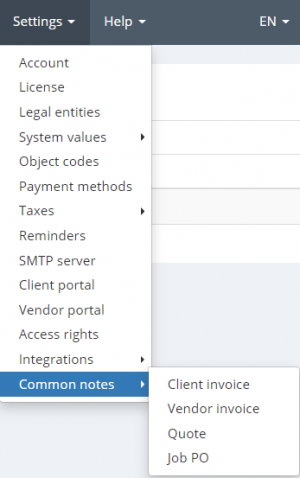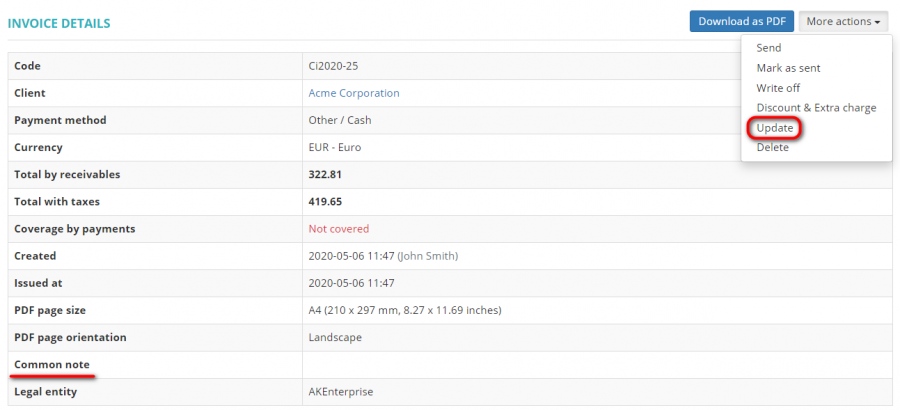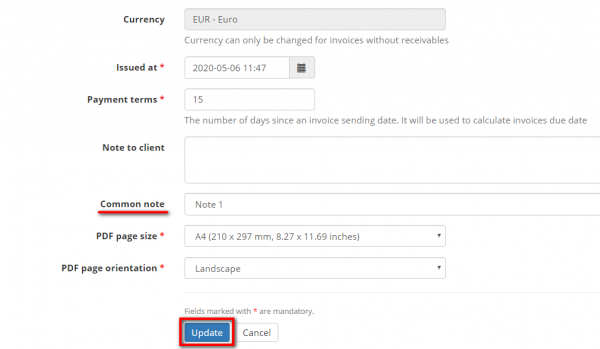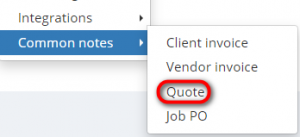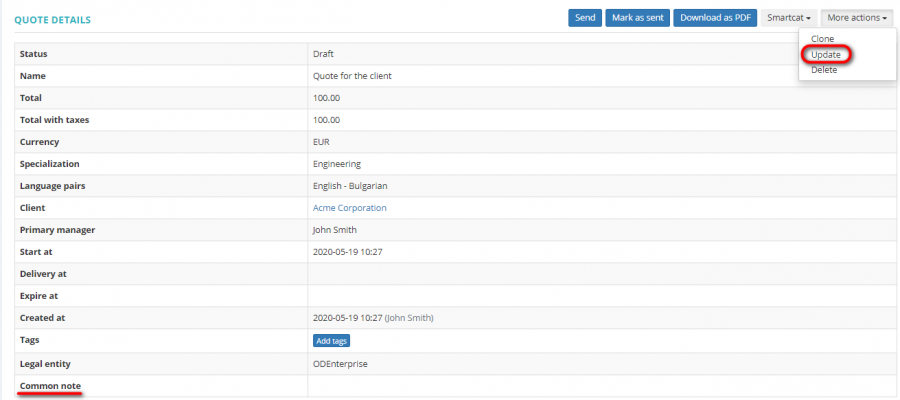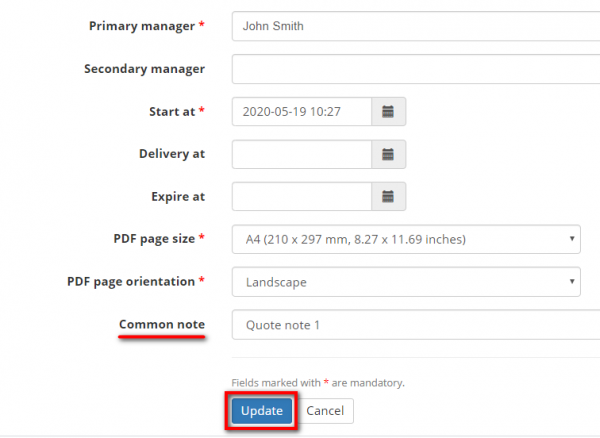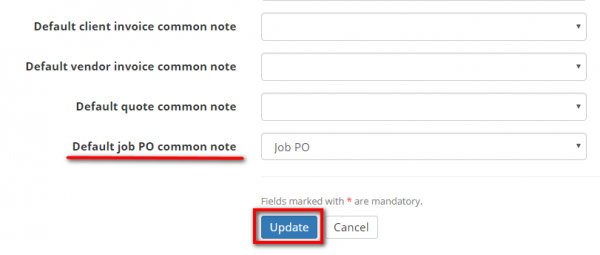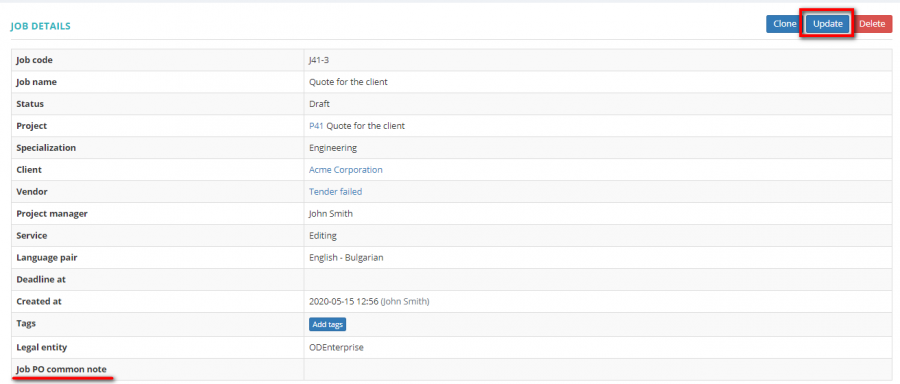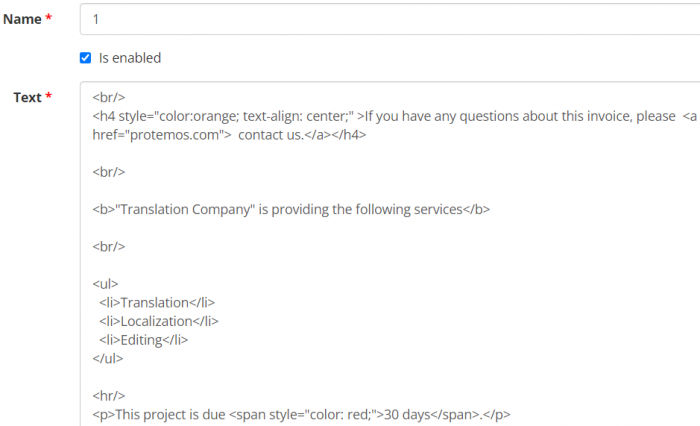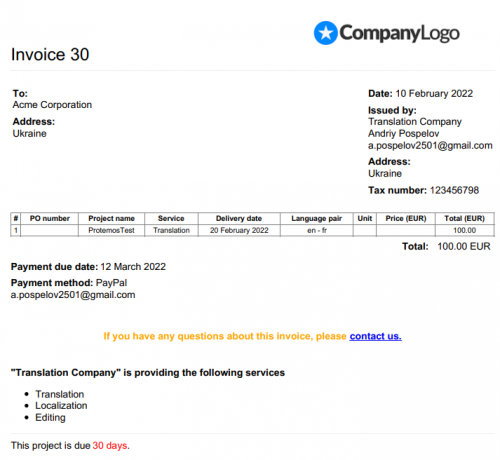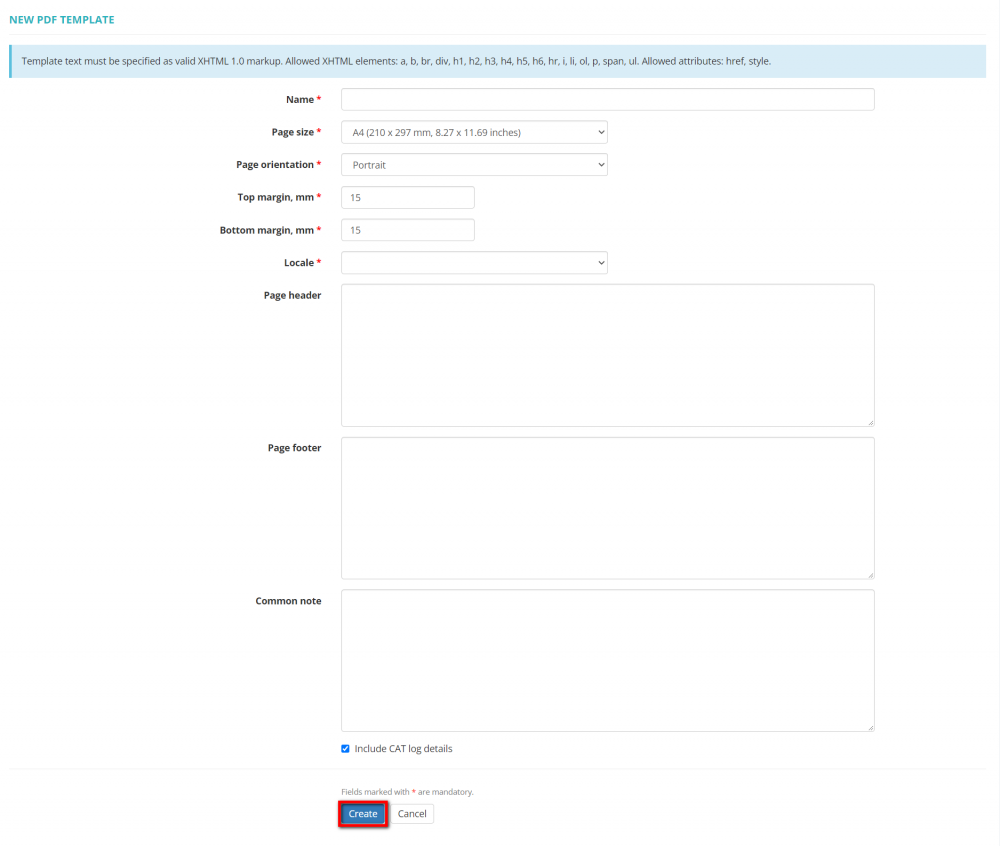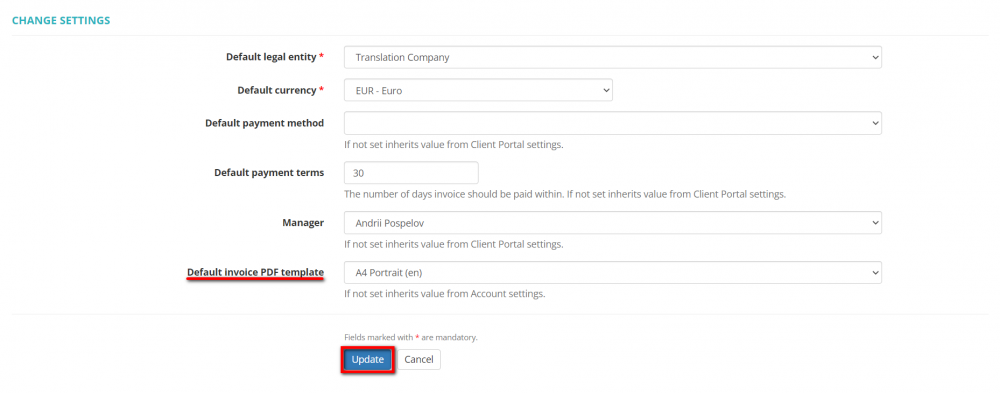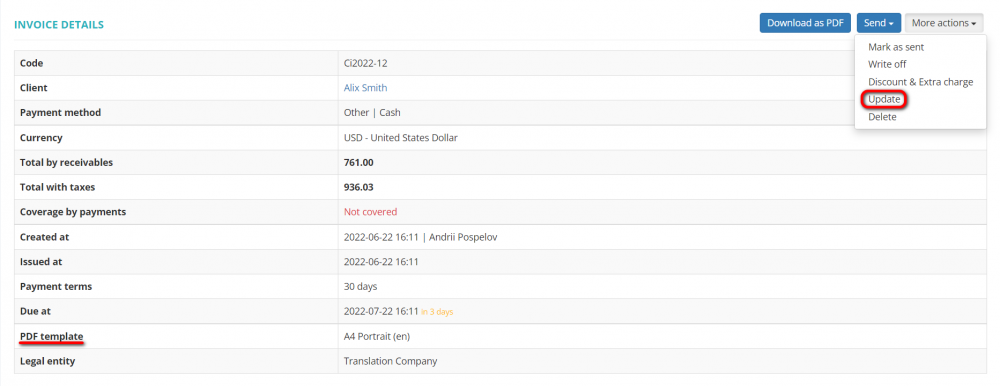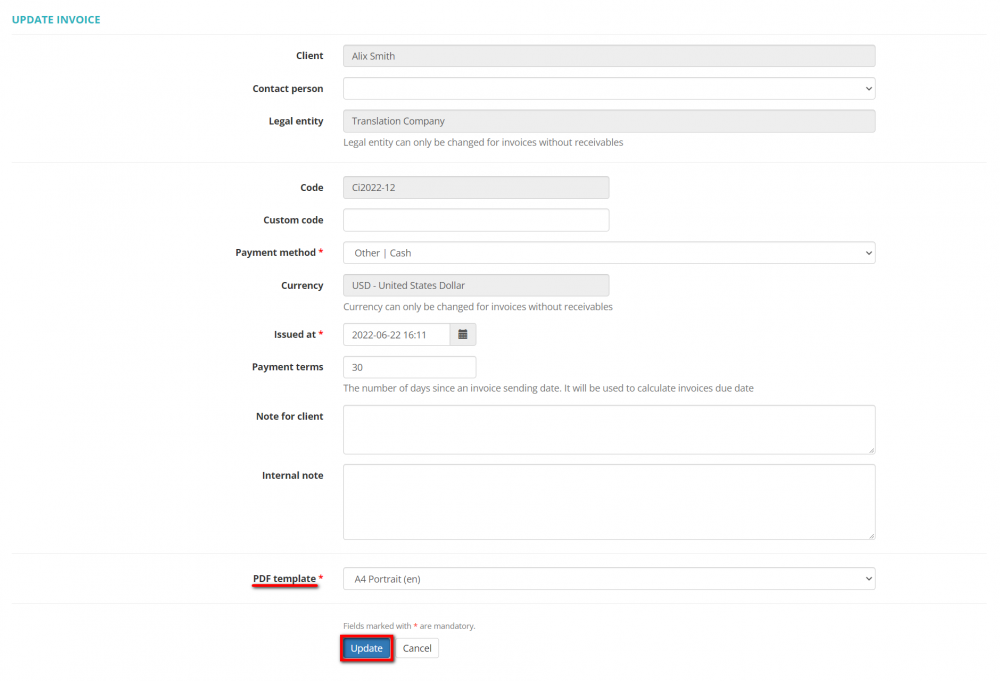Difference between revisions of "PDF templates"
| Line 1: | Line 1: | ||
| − | <span style="color:red"> | + | Watch our video tutorial on Common notes - [[File:2ag.png|40px|link=https://youtu.be/hCA48afcmR4]] |
| + | |||
| + | You can define common notes for client invoices, vendor invoices, quotes and job PO. | ||
| + | |||
| + | Common note text can contain valid XHTML 1.0 markup. Allowed XHTML elements: a, b, br, div, h1, h2, h3, h4, h5, h6, hr, i, li, ol, p, span, ul. Allowed attributes: href, style. | ||
| + | |||
| + | To add the common notes, go to '''Settings → Common notes:''' | ||
| + | |||
| + | [[File:Screreenshot 1.png|border|300px]] | ||
| + | |||
| + | You always can update or delete the note: | ||
| + | |||
| + | [[File:SsScreenshot 1.png|border|800px]] | ||
| + | |||
| + | =='''Client invoice common notes'''== | ||
| + | |||
| + | To add the client invoice common notes, go to '''Settings → Common notes → Client invoice''': | ||
| + | |||
| + | [[File:1 client cn.png|border|300px]] | ||
| + | |||
| + | Press '''"New common note"''': | ||
| + | |||
| + | [[File:2 client cn.png|border|900px]] | ||
| + | |||
| + | Enter the name, the comment, and press '''"Create"''': | ||
| + | |||
| + | [[File:1NEW UPD.png|border|900px]] | ||
| + | |||
| + | You can define a default client invoice common note and it will be displayed in every client invoice you issue. | ||
| + | |||
| + | Go to the '''Account''' page, scroll down to the Default settings, and press '''"Update"''': | ||
| + | |||
| + | [[File:Default common note.png|border|900px]] | ||
| + | |||
| + | From the drop-won list choose the needed one, and press '''"Update"''': | ||
| + | |||
| + | [[File:1325.png|border|900px]] | ||
| + | |||
| + | You can add a common note in an invoice. | ||
| + | |||
| + | Open the needed invoice and press '''"Update"''': | ||
| + | |||
| + | [[File:Screekknshot 2.png|border|900px]] | ||
| + | |||
| + | Choose the needed invoice common note from the drop-down list, and press '''"Update"''': | ||
| + | |||
| + | [[File:Scrseeddnshot 3.png|border|600px]] | ||
| + | |||
| + | [[File:Redirect.jpg|40px|link=Common notes]] Back to the '''table of contents'''. | ||
| + | |||
| + | =='''Vendor invoice common notes'''== | ||
| + | |||
| + | To add the vendor invoice common notes, go to '''Settings → Common notes → Vendor invoice''': | ||
| + | |||
| + | [[File:Vendvor cn.png|border|300px]] | ||
| + | |||
| + | Press '''"New common note"''': | ||
| + | |||
| + | [[File:New cn.png|border|900px]] | ||
| + | |||
| + | Enter the name, the comment, and press '''"Create"''': | ||
| + | |||
| + | [[File:1 nedw.png|border|900px]] | ||
| + | |||
| + | You can define a default vendor invoice common note that will be displayed in every vendors' invoices you issue. | ||
| + | |||
| + | Go to the '''Account''' page, scroll down to the Default settings, and press '''"Update"''': | ||
| + | |||
| + | [[File:Updacte.png|border|900px]] | ||
| + | |||
| + | From the drop-won list choose the needed one, and press '''"Update"''': | ||
| + | |||
| + | [[File:2c2 vcm.png|border|900px]] | ||
| + | |||
| + | You can update the common vendor invoice note in invoices. Open the needed invoice and press '''"Update"''': | ||
| + | |||
| + | [[File:Screenshot 9.png|border|900px]] | ||
| + | |||
| + | Choose the needed invoice common note from the drop-down list, and press '''"Update"''': | ||
| + | |||
| + | [[File:Sccreenshot 8.png|border|600px]] | ||
| + | |||
| + | [[File:Redirect.jpg|40px|link=Common notes]] Back to the '''table of contents'''. | ||
| + | |||
| + | =='''Quote common notes'''== | ||
| + | |||
| + | To add the quote common notes, go to '''Settings → Common notes → Quote''': | ||
| + | |||
| + | [[File:Quote common note.png|border|300px]] | ||
| + | |||
| + | Press '''"New common note"''': | ||
| + | |||
| + | [[File:Screenffshot 2.png|border|900px]] | ||
| + | |||
| + | Enter the name, the comment, and press '''"Create"''': | ||
| + | |||
| + | [[File:Screeddnshot 3.png|border|900px]] | ||
| + | |||
| + | You can define a default quote common note that will be added to every quote you create. | ||
| + | |||
| + | Go to the '''Account''' page, scroll down to the Default settings, and press '''"Update"''': | ||
| + | |||
| + | [[File:1 upd fef comm.png|border|900px]] | ||
| + | |||
| + | From the drop-down list choose the needed one, and press '''"Update"''': | ||
| + | |||
| + | [[File:Screednddshot 4.png|border|600px]] | ||
| + | |||
| + | ==='''Add a quote common note'''=== | ||
| + | |||
| + | You can update the common quote note in the needed quote when you create it. | ||
| + | |||
| + | You also can add the common not by pressing the '''"Update"''': | ||
| + | |||
| + | [[File:Screejjlnshot 4.png|border|900px]] | ||
| + | |||
| + | Choose the needed quote common note from the drop-down list, and press '''"Update"''': | ||
| + | |||
| + | [[File:Screeasdnshot 5.png|border|600px]] | ||
| + | |||
| + | [[File:Redirect.jpg|40px|link=Common notes]] Back to the '''table of contents'''. | ||
| + | |||
| + | =='''Job PO common notes'''== | ||
| + | |||
| + | To add the job PO common notes, go to '''Settings → Common notes → Job PO''': | ||
| + | |||
| + | [[File:1 common note.png|border|300px]] | ||
| + | |||
| + | Press '''"New common note"''': | ||
| + | |||
| + | [[File:Scrcsdeenshot 1.png|border|900px]] | ||
| + | |||
| + | Enter the name, the comment, and press '''"Create"''': | ||
| + | |||
| + | [[File:Screenvvvvvshot 2.png|border|900px]] | ||
| + | |||
| + | You can define a default job PO common note that will be added to every job you create. | ||
| + | |||
| + | Go to the '''Account''' page, scroll down to the Default settings, and press '''"Update"''': | ||
| + | |||
| + | [[File:Updsfefate.png|border|900px]] | ||
| + | |||
| + | From the drop-down list choose the needed one, and press '''"Update"''': | ||
| + | |||
| + | [[File:Screensaswfhot 3.png|border|600px]] | ||
| + | |||
| + | You can update the common job PO note for the needed job when you create it. | ||
| + | |||
| + | Or open already created job and press '''"Update"''': | ||
| + | |||
| + | [[File:Scdrreenshot 6.png|border|900px]] | ||
| + | |||
| + | Choose the needed job PO common note from the drop-down list, and press '''"Update"''': | ||
| + | |||
| + | [[File:Screenshot 7.png|border|450px]] | ||
| + | |||
| + | [[File:Redirect.jpg|40px|link=Common notes]] Back to the '''table of contents'''. | ||
| + | |||
| + | =='''XHTML elements and attributes'''== | ||
| + | |||
| + | {| style="width:1200px" border="1" class="mw-datatable" | ||
| + | |||
| + | |-style="height:40px" | ||
| + | |1. " valign="top" align="center" width="100" | '''TAG''' | ||
| + | |2. " valign="top" align="center" width="300" | '''DESCRIPTION''' | ||
| + | |3. " valign="top" align="center" width="300" | '''EXAMPLE''' | ||
| + | |4. " valign="top" align="center" width="300" | '''VIEW''' | ||
| + | |||
| + | |-style="height:10px" | ||
| + | |1. " valign="top" align="center" width="100" | '''<nowiki><a href></nowiki>''' | ||
| + | |2. " valign="top" align="left" width="300" | The <a> tag defines a hyperlink, which is used to link from one page to another. The most important attribute of the <a> element is the href attribute, which indicates the link's destination. | ||
| + | |3. " valign="top" align="left" width="300" | <nowiki><a href="protemos.com">Visit my website</a></nowiki> | ||
| + | <br> <nowiki><a href="mailto:as@protemos.com">as@protemos.com</a></nowiki> | ||
| + | |||
| + | |4. " valign="top" align="center" width="300" | [[File:1 V.png|150px]] | ||
| + | |||
| + | |-style="height:40px" | ||
| + | |1. " valign="top" align="center" width="100" | '''<nowiki><b></nowiki>''' | ||
| + | |2. " valign="top" align="left" width="300" | The tag specifies bold text without any extra importance. | ||
| + | |3. " valign="top" align="left" width="300" | <nowiki><b>This text is bold</b></nowiki> | ||
| + | |4. " valign="top" align="center" width="300" | [[File:2 B.png|130px]] | ||
| + | |||
| + | |-style="height:40px" | ||
| + | |1. " valign="top" align="center" width="100" | '''<nowiki><br/></nowiki>''' | ||
| + | |2. " valign="top" align="left" width="300" | The tag inserts a single line break. | ||
| + | |3. " valign="top" align="left" width="300" | <nowiki><br/></nowiki> | ||
| + | |||
| + | |-style="height:40px" | ||
| + | |1. " valign="top" align="center" width="100" | '''<nowiki><div></nowiki>''' | ||
| + | |2. " valign="top" align="left" width="300" | Defines a division part. It's a block-level element | ||
| + | |3. " valign="top" align="left" width="300" | <nowiki><div style="text-align: center;">This text is in the center.</div></nowiki> | ||
| + | |4. " valign="top" align="center" width="300" | [[File:Centre.png|150px]] | ||
| + | |||
| + | |-style="height:40px" | ||
| + | |1. " valign="top" align="center" width="100" | '''<nowiki><h1> to <h6></nowiki>''' | ||
| + | |2. " valign="top" align="left" width="300" | Defines Headings level from 1 to 6 different sizes. | ||
| + | |3. " valign="top" align="left" width="300" | <nowiki><h1 style="color:blue;">This is a heading</h1></nowiki> | ||
| + | |4. " valign="top" align="center" width="300" | [[File:3 H.png|200px]] | ||
| + | |||
| + | |-style="height:40px" | ||
| + | |1. " valign="top" align="center" width="100" | '''<nowiki><hr></nowiki>''' | ||
| + | |2. " valign="top" align="left" width="300" | Represents a thematic break between paragraph-level tags. It is typically drawn horizontal line. | ||
| + | |3. " valign="top" align="left" width="300" | <nowiki><hr/></nowiki> | ||
| + | |4. " valign="top" align="center" width="300" | [[File:1 line.png|140px]] | ||
| + | |||
| + | |-style="height:40px" | ||
| + | |1. " valign="top" align="center" width="100" | '''<nowiki><i></nowiki>''' | ||
| + | |2. " valign="top" align="left" width="300" | The content inside is typically displayed in ''italic''. | ||
| + | |3. " valign="top" align="left" width="300" | <nowiki><i>This text is italic</i></nowiki> | ||
| + | |4. " valign="top" align="center" width="300" | [[File:4 I.png|110px]] | ||
| + | |||
| + | |-style="height:40px" | ||
| + | |1. " valign="top" align="center" width="100" | '''<nowiki><li></nowiki>''' | ||
| + | |2. " valign="top" align="left" width="300" | The tag defines a list item. The <nowiki><li></nowiki> tag is used inside ordered lists(<nowiki><ol></nowiki>), unordered lists (<nowiki><ul></nowiki>) | ||
| + | |3. " valign="top" align="left" width="300" | <nowiki><ol> | ||
| + | <li>Quote</li> | ||
| + | <li>Project</li> | ||
| + | <li>Job</li> | ||
| + | </ol></nowiki> | ||
| + | |4. " valign="top" align="center" width="300" | [[File:8Q.png|80px]] | ||
| + | |||
| + | |-style="height:40px" | ||
| + | |1. " valign="top" align="center" width="100" | '''<nowiki><ol></nowiki>''' | ||
| + | |2. " valign="top" align="left" width="300" | The tag defines an ordered list. An ordered list can be numerical or alphabetical. The <nowiki><li></nowiki> tag is used to define each list item. | ||
| + | |3. " valign="top" align="left" width="300" | <nowiki><ol> | ||
| + | <li>Quote</li> | ||
| + | <li>Project</li> | ||
| + | <li>Job</li> | ||
| + | </ol></nowiki> | ||
| + | |4. " valign="top" align="center" width="300" | [[File:8Q.png|80px]] | ||
| + | |||
| + | |-style="height:40px" | ||
| + | |1. " valign="top" align="center" width="100" | '''<nowiki><p></nowiki>''' | ||
| + | |2. " valign="top" align="left" width="300" |The tag defines a paragraph. | ||
| + | |3. " valign="top" align="left" width="300" | <nowiki><p>This project is due <span style="color: red;">30 days</span>.</p></nowiki> | ||
| + | |4. " valign="top" align="center" width="300" | [[File:1 th.png|160px]] | ||
| + | |||
| + | |-style="height:40px" | ||
| + | |1. " valign="top" align="center" width="100" | '''<nowiki><span></nowiki>''' | ||
| + | |2. " valign="top" align="left" width="300" | The tag is an inline container used to mark up a part of a text, or a part of a document. The <span> tag is much like the <nowiki><div></nowiki> element, but <nowiki><div></nowiki> is a block-level element and <span> is an inline element. | ||
| + | |3. " valign="top" align="left" width="300" | <nowiki><p>This is a <span style="color:blue;"> paragraph</span>.</p></nowiki> | ||
| + | |4. " valign="top" align="center" width="300" | [[File:5. P.png|130px]] | ||
| + | |||
| + | |-style="height:40px" | ||
| + | |1. " valign="top" align="center" width="100" | '''<nowiki><ul></nowiki>''' | ||
| + | |2. " valign="top" align="left" width="300" | The tag defines an unordered (bulleted) list. Use the <nowiki><ul></nowiki> tag together with the <nowiki><li></nowiki> tag to create unordered lists. | ||
| + | |3. " valign="top" align="left" width="300" | <nowiki> | ||
| + | <ul> | ||
| + | <li>Quote</li> | ||
| + | <li>Project</li> | ||
| + | <li>Job</li> | ||
| + | </ul> | ||
| + | </nowiki> | ||
| + | |4. " valign="top" align="center" width="300" | [[File:6. Q.png|80px]] | ||
| + | |||
| + | |-style="height:40px" | ||
| + | |1. " valign="top" align="center" width="100" | '''<nowiki><style></nowiki>''' | ||
| + | |2. " valign="top" align="left" width="300" | <br>Used to add CSS style, e.g.: <br> - '''Underline the text''' <hr/> <br>- '''Align the text'''<hr/> - '''Change the size of the text'''. <br> | ||
| + | |3. " valign="top" align="left" width="300" | <br> <nowiki><p style="text-decoration: underline;"> Underlined text </p></nowiki> <hr/> <nowiki><p style="text-align: center;">This text is in the center.</p> </nowiki> <hr/> <nowiki> <p style="font-size:12px">This text size is 12 px.</p></nowiki> | ||
| + | |4. " valign="top" align="center" width="300" | <br> [[File:Underlined.png|125px]] <br> [[File:Centre.png|175px]]<br>[[File:Font.png|125px]] | ||
| + | |||
| + | |} | ||
| + | |||
| + | For text to start from a new page - <nowiki><p style="clear: both; display: block; page-break-after: always;"></p></nowiki> | ||
| + | |||
| + | |||
| + | |||
| + | That's the example on how your invoice can look like: | ||
| + | |||
| + | [[File:Common notes html example2.png|700px]] [[File:Common notes html example1.png|border|500px]] | ||
| + | |||
| + | <span style="color:red">Note:</span> please avoid this sign '''&''' because the system doesn't allow to save the common note. | ||
| + | |||
| + | [[File:Redirect.jpg|40px|link=Common notes]] Back to the '''table of contents'''. | ||
| + | |||
| + | =='''PDF Templates'''== | ||
| + | |||
| + | <span style="color:red">Described features will be available with the forthcoming system release.</span> | ||
You can create PDF templates for client invoices, vendor invoices, quotes, and job PO. | You can create PDF templates for client invoices, vendor invoices, quotes, and job PO. | ||
| − | PDF | + | PDF templates text can contain valid XHTML 1.0 markup. Allowed XHTML elements: a, b, br, div, h1, h2, h3, h4, h5, h6, hr, i, li, ol, p, span, ul. Allowed attributes: href, style. |
To create a template, go to '''Settings → PDF Templates:''' | To create a template, go to '''Settings → PDF Templates:''' | ||
| Line 11: | Line 288: | ||
You always can clone, update or delete the templates: | You always can clone, update or delete the templates: | ||
| − | [[File: | + | [[File:Client invoice pdf templates+.png|border|1000px]] |
=='''Client invoice PDF templates'''== | =='''Client invoice PDF templates'''== | ||
| Line 17: | Line 294: | ||
To create the client invoice PDF template, go to '''Settings → PDF Templates → Client invoice''': | To create the client invoice PDF template, go to '''Settings → PDF Templates → Client invoice''': | ||
| − | [[File: | + | [[File:PDF templates - client invoice.png|border|300px]] |
Click '''"New PDF template"''': | Click '''"New PDF template"''': | ||
| Line 23: | Line 300: | ||
[[File:2 client cn.png|border|900px]] | [[File:2 client cn.png|border|900px]] | ||
| − | Fill in the fields | + | Fill in the fields, select the needed options and click "Create": |
| + | |||
| + | [[File:New cl invoice pdf template2.png|border|1000px]] | ||
*'''Name''' — a name of the template; | *'''Name''' — a name of the template; | ||
| Line 43: | Line 322: | ||
*'''Common note''' — a text that appears after the payment method description; | *'''Common note''' — a text that appears after the payment method description; | ||
| − | + | You can define a default client invoice PDF template that will be applied to invoices for all the new clients. | |
| − | |||
| − | You can define a default client invoice PDF template | ||
Go to the '''Account''' page, scroll down to the Default settings, and click '''"Update"''': | Go to the '''Account''' page, scroll down to the Default settings, and click '''"Update"''': | ||
| Line 53: | Line 330: | ||
Select the needed one from the drop-down list and click '''"Update"''': | Select the needed one from the drop-down list and click '''"Update"''': | ||
| − | [[File: | + | [[File:Account settings cl invoice+.png|border|1000px]] |
You can also select the default client invoice PDF template for each client. | You can also select the default client invoice PDF template for each client. | ||
Go to the needed client profile, scroll down to the Settings section and click '''"Update"''': | Go to the needed client profile, scroll down to the Settings section and click '''"Update"''': | ||
| + | |||
| + | [[File:Client profile setting section.png|border|1000px]] | ||
Select the template from the drop-down list and click '''"Update"''': | Select the template from the drop-down list and click '''"Update"''': | ||
| − | + | [[File:Client profile settings section1.png|border|1000px]] | |
| − | Open the needed invoice and click '''"Update"''': | + | If needed, you can select the template for a specific client invoice. Open the needed invoice and click '''"Update"''': |
| − | [[File: | + | [[File:Update client invoice.png|border|1000px]] |
Choose the template from the drop-down list, and click '''"Update"''': | Choose the template from the drop-down list, and click '''"Update"''': | ||
| − | [[File: | + | [[File:Update cl invoice2.png|border|1000px]] |
[[File:Redirect.jpg|40px|link=Common notes]] Back to the '''table of contents'''. | [[File:Redirect.jpg|40px|link=Common notes]] Back to the '''table of contents'''. | ||
| − | =='''Vendor invoice | + | =='''Vendor invoice PDF templates'''== |
| + | |||
| + | To add the vendor invoice PDF templates, go to '''Settings → PDF Templates → Vendor invoice''': | ||
| + | |||
| + | [[File:PDF templates - vendor invoice.png|border|300px]] | ||
| + | |||
| + | Click '''"New PDF template"''': | ||
| + | |||
| + | [[File:New vendor invoice PDF templates.png|border|1000px]] | ||
| + | |||
| + | Fill in the fields, select the needed options and click "Create": | ||
| + | |||
| + | [[File:New cl invoice pdf template2.png|border|1000px]] | ||
| + | |||
| + | *'''Name''' — a name of the template; | ||
| + | |||
| + | *'''Page size''' — select whether the page size is A4 or a letter size; | ||
| + | |||
| + | *'''Page orientation''' — select the portrait or landscape page orientation; | ||
| − | + | *'''Top margin, mm''' — select the top margin height in millimeters; | |
| − | + | *'''Bottom margin, mm''' — select the bottom margin height in millimeters; | |
| − | + | *'''Locale''' - locale defines the language of the template text; | |
| − | + | *'''Page header''' — a text that appears at the top of the page; | |
| − | + | *'''Page footer''' — a text that appears at the bottom of the page; | |
| − | + | *'''Common note''' — a text that appears after the payment method description; | |
| − | You can define a default vendor invoice | + | You can define a default vendor invoice PDF template that will be applied to invoices for all the new vendors. |
| − | Go to the '''Account''' page, scroll down to the Default settings, and | + | Go to the '''Account''' page, scroll down to the Default settings, and click '''"Update"''': |
| − | [[File: | + | [[File:Account settings - def v invoice template.png|border|1000px]] |
| − | + | Select the needed one from the drop-down list and click '''"Update"''': | |
[[File:2c2 vcm.png|border|900px]] | [[File:2c2 vcm.png|border|900px]] | ||
Revision as of 12:01, 19 July 2022
Watch our video tutorial on Common notes - ![]()
You can define common notes for client invoices, vendor invoices, quotes and job PO.
Common note text can contain valid XHTML 1.0 markup. Allowed XHTML elements: a, b, br, div, h1, h2, h3, h4, h5, h6, hr, i, li, ol, p, span, ul. Allowed attributes: href, style.
To add the common notes, go to Settings → Common notes:
You always can update or delete the note:
Contents
Client invoice common notes
To add the client invoice common notes, go to Settings → Common notes → Client invoice:
Press "New common note":
Enter the name, the comment, and press "Create":
You can define a default client invoice common note and it will be displayed in every client invoice you issue.
Go to the Account page, scroll down to the Default settings, and press "Update":
From the drop-won list choose the needed one, and press "Update":
You can add a common note in an invoice.
Open the needed invoice and press "Update":
Choose the needed invoice common note from the drop-down list, and press "Update":
![]() Back to the table of contents.
Back to the table of contents.
Vendor invoice common notes
To add the vendor invoice common notes, go to Settings → Common notes → Vendor invoice:
Press "New common note":
Enter the name, the comment, and press "Create":
You can define a default vendor invoice common note that will be displayed in every vendors' invoices you issue.
Go to the Account page, scroll down to the Default settings, and press "Update":
From the drop-won list choose the needed one, and press "Update":
You can update the common vendor invoice note in invoices. Open the needed invoice and press "Update":
Choose the needed invoice common note from the drop-down list, and press "Update":
![]() Back to the table of contents.
Back to the table of contents.
Quote common notes
To add the quote common notes, go to Settings → Common notes → Quote:
Press "New common note":
Enter the name, the comment, and press "Create":
You can define a default quote common note that will be added to every quote you create.
Go to the Account page, scroll down to the Default settings, and press "Update":
From the drop-down list choose the needed one, and press "Update":
Add a quote common note
You can update the common quote note in the needed quote when you create it.
You also can add the common not by pressing the "Update":
Choose the needed quote common note from the drop-down list, and press "Update":
![]() Back to the table of contents.
Back to the table of contents.
Job PO common notes
To add the job PO common notes, go to Settings → Common notes → Job PO:
Press "New common note":
Enter the name, the comment, and press "Create":
You can define a default job PO common note that will be added to every job you create.
Go to the Account page, scroll down to the Default settings, and press "Update":
From the drop-down list choose the needed one, and press "Update":
You can update the common job PO note for the needed job when you create it.
Or open already created job and press "Update":
Choose the needed job PO common note from the drop-down list, and press "Update":
![]() Back to the table of contents.
Back to the table of contents.
XHTML elements and attributes
For text to start from a new page - <p style="clear: both; display: block; page-break-after: always;"></p>
That's the example on how your invoice can look like:
Note: please avoid this sign & because the system doesn't allow to save the common note.
![]() Back to the table of contents.
Back to the table of contents.
PDF Templates
Described features will be available with the forthcoming system release.
You can create PDF templates for client invoices, vendor invoices, quotes, and job PO.
PDF templates text can contain valid XHTML 1.0 markup. Allowed XHTML elements: a, b, br, div, h1, h2, h3, h4, h5, h6, hr, i, li, ol, p, span, ul. Allowed attributes: href, style.
To create a template, go to Settings → PDF Templates:
You always can clone, update or delete the templates:
Client invoice PDF templates
To create the client invoice PDF template, go to Settings → PDF Templates → Client invoice:
Click "New PDF template":
Fill in the fields, select the needed options and click "Create":
- Name — a name of the template;
- Page size — select whether the page size is A4 or a letter size;
- Page orientation — select the portrait or landscape page orientation;
- Top margin, mm — select the top margin height in millimeters;
- Bottom margin, mm — select the bottom margin height in millimeters;
- Locale - locale defines the language of the template text;
- Page header — a text that appears at the top of the page;
- Page footer — a text that appears at the bottom of the page;
- Common note — a text that appears after the payment method description;
You can define a default client invoice PDF template that will be applied to invoices for all the new clients.
Go to the Account page, scroll down to the Default settings, and click "Update":
Select the needed one from the drop-down list and click "Update":
You can also select the default client invoice PDF template for each client.
Go to the needed client profile, scroll down to the Settings section and click "Update":
Select the template from the drop-down list and click "Update":
If needed, you can select the template for a specific client invoice. Open the needed invoice and click "Update":
Choose the template from the drop-down list, and click "Update":
![]() Back to the table of contents.
Back to the table of contents.
Vendor invoice PDF templates
To add the vendor invoice PDF templates, go to Settings → PDF Templates → Vendor invoice:
Click "New PDF template":
Fill in the fields, select the needed options and click "Create":
- Name — a name of the template;
- Page size — select whether the page size is A4 or a letter size;
- Page orientation — select the portrait or landscape page orientation;
- Top margin, mm — select the top margin height in millimeters;
- Bottom margin, mm — select the bottom margin height in millimeters;
- Locale - locale defines the language of the template text;
- Page header — a text that appears at the top of the page;
- Page footer — a text that appears at the bottom of the page;
- Common note — a text that appears after the payment method description;
You can define a default vendor invoice PDF template that will be applied to invoices for all the new vendors.
Go to the Account page, scroll down to the Default settings, and click "Update":
Select the needed one from the drop-down list and click "Update":
You can update the common vendor invoice note in invoices. Open the needed invoice and press "Update":
Choose the needed invoice common note from the drop-down list, and press "Update":
![]() Back to the table of contents.
Back to the table of contents.
Quote common notes
To add the quote common notes, go to Settings → Common notes → Quote:
Press "New common note":
Enter the name, the comment, and press "Create":
You can define a default quote common note that will be added to every quote you create.
Go to the Account page, scroll down to the Default settings, and press "Update":
From the drop-down list choose the needed one, and press "Update":
Add a quote common note
You can update the common quote note in the needed quote when you create it.
You also can add the common not by pressing the "Update":
Choose the needed quote common note from the drop-down list, and press "Update":
![]() Back to the table of contents.
Back to the table of contents.
Job PO common notes
To add the job PO common notes, go to Settings → Common notes → Job PO:
Press "New common note":
Enter the name, the comment, and press "Create":
You can define a default job PO common note that will be added to every job you create.
Go to the Account page, scroll down to the Default settings, and press "Update":
From the drop-down list choose the needed one, and press "Update":
You can update the common job PO note for the needed job when you create it.
Or open already created job and press "Update":
Choose the needed job PO common note from the drop-down list, and press "Update":
![]() Back to the table of contents.
Back to the table of contents.
XHTML elements and attributes
For text to start from a new page - <p style="clear: both; display: block; page-break-after: always;"></p>
That's the example on how your invoice can look like:
Note: please avoid this sign & because the system doesn't allow to save the common note.
